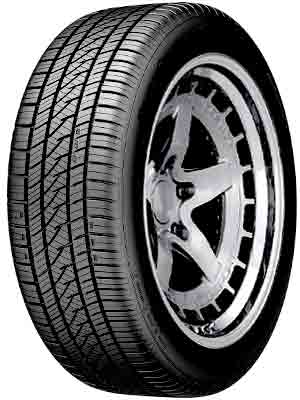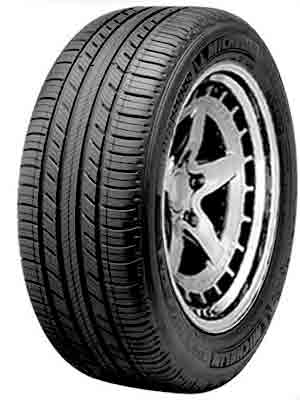These tires are Grand Touring All-Season tires and provide amazing traction on both dry and wet roads. PureContact LS offers a little better traction on dry roads, while the Premier A/S provides good traction on wet surfaces.
Keep reading to find out about the unique features in both of these tires that make them one of the best tires in their line.

Table of Contents
Comparing PureContact LS with Michelin Premier AS
Continental PureContact LS

Michelin Premier AS


Vs

The PureContact LS features an asymmetric tread design with a solid wide central rib that offers reliable traction by providing a considerable surface area to grip the ground. This not only promotes superior aptitude in braking but also better handling response on dry and wet roads as a consequence. It contains four narrow but deep circumferential grooves and an adequate amount of sipes that help it to sustain grip on wet surfaces by effectively capturing water in its channels. Therefore, its grip is not compromised even in damped conditions while turning and cornering. Its inbuilt structural features (discussed at the end) make it smooth and stable in addition to improving its tread wear. This makes it an optimal tire for touring and long drives.
On the other side, Premier A/S has a symmetrical tread design with a central rib aided by two notched ribs on both sides. It gives the tire stability as well as provides a good surface area to grip the road (but its surface area is a little smaller than LS). It contains slightly wider grooves and a somewhat greater amount of sipes than its adversary so it has sufficient traction on wet surfaces and avoids aquaplaning to a great extent. Thus, it also allows it to sustain its grip during cornering and turning in moist conditions. It wears out fast than the LS because it is not as well-built as its competitor.
Comparison of Road Grip
The L/S has a relatively compact tread pattern with a bit more closely placed tread blocks (than the A/S). It results in a larger surface area to adhere to the surface of the road and increases its grip. As a consequence, it provides a greater biting power that improves its traction on dry roads. It stops quickly on applying brakes due to its increased road grip by the virtue of its large contact patch, it increases its friction with the surface and makes it easier to stop.
In contrast, Michelin AS has a comparatively open tread pattern with scarcely placed tread blocks to some degree. Therefore, it contains a moderately smaller footprint and a lower grip in the aftermath. Accordingly, due to its less astounding grip, it has a longer stopping distance on dry surfaces than its competitor. Henceforth, L/S has better traction as well as better braking capabilities than the A/S on dry roads.
Tire Handling Comparison
Handling is originally determined by the shoulders of the tire. LS has a rather obscure but greater number of sipes on its shoulders. It results in better handling and cornering ability of the tire on dry roads because it has a larger surface area on its shoulders that grips the road during turning and cornering. Nonetheless, it has shallow but a considerable amount of sipes that have a reliable ability to grip wet roads. So, it can firmly grip during cornering on wet surfaces and maintains its steering response in damped conditions.
While A/S contains more prominent sipes but they are present in less amount on its shoulders with the addition of dimples. These dimples work in conjunction with the sipes to provide a steady grip while cornering in wet conditions. But these sipes and dimples decrease the contact patch of the shoulder and therefore decrease its handling and cornering ability on dry roads. Henceforth, A/S has a good cornering ability and handling on wet roads. But, LS has more dependable handling on dry surfaces.
Comparison of Hydroplaning Resistance
The A/S has a slightly better void ratio in its 4 deep circumferential grooves. Due to this, it can collect a considerable amount of water in its gaps to remain in contact with the road in wet conditions. Therefore, it can effectively avoid hydroplaning during rainy seasons. What’s more, this tire has a considerable amount of sipes to further wipe away water from its treads, and additionally aid in its wet traction. This tire owns two extra features. The first one is the expanding rain grooves; these grooves expand as the tire wears. The second one is the emerging grooves in its shoulder that open up as the tire wears. This makes the tire uphold its grip on wet surfaces even when the tire gets old. Consequently, it can perform well during braking in wet conditions due to the considerable void ratio that provides it with enough friction to effectively stop the vehicle.
Conversely, L/S contains a relatively smaller void ratio in its fairly deep and wide circumferential grooves but it lacks lateral grooves in the middle, unlike the LS. Therefore, it has a lower ability to evacuate water from its tread and help it stand its ground on wet surfaces. Moreover, it has more prominent sipes but are available in a scarce amount which aids in its ability to push away water from its treads. When the weather conditions are extreme, it cannot outperform the AS, because it doesn’t have as good water evacuating ability in its narrower grooves (compared to A/S) with a reasonably lower void ratio. Therefore, it takes longer to stop on wet roads in comparison with the A/S.
Comparison of Rolling Resistance
Temperature-activated functional polymers are embedded in the tread compound of PureContact LS which increases the compound bonding and improves the wear and tear characteristics on this tire. Its internal construction is assembled with a single ply, polyester casing, and dual steel belts covered by two polyamide coats that enhance its stability. Moving forward, its tread blocks are placed a bit close to each other which enlarges its surface area that should increase its rolling resistance. But this is not the case, the tread compound and internal structure of the tire enables it to have better rolling resistance. So, it also has a better economy and efficiency than its contender.
Premier A/S features a silica and sunflower oil enhanced tread compound that aids to improve the tire’s tread wear. Its internal structure contains twin steel belts strengthened with a polyamide cord. On top of all these, it contains polyester casing ply on its steel belts that further enhances its stability. Its tread blocks are placed a bit far from each other than the LS. Thus, it has a smaller footprint which lowers its rolling resistance and takes less power to spin on-road. This makes it economical and proficient. But then again, its structural makeup is not as good as the LS. Therefore, it cannot beat LS in this domain, as its tread wear is far better than this tire.
Comfort and Noise Comparison
Comfort is the main focus of all grand touring tires. LS incorporates Comfort Ride Technology with an underlay under its tread. It is designed to reduce the vibrations in the cabin of the car and provide a smooth ride. On top of that, it has small cavities that entrap only a negligible amount of air. Therefore, it generates less noise and fewer vibrations by the collision of these trivial air particles. This makes it one of the most comfortable and smooth tires in the market.
Michelin Premier A/S has a larger cavity between its tread blocks than LS that captures more air and produces somewhat louder noise and greater vibrations by the collisions of air particles in its wide grooves. This makes it relatively less comfortable. Still, it is one of the most comfortable tires in its domain.
Quick Summary
- Both of the tires are Grand Touring All-Season tires.
- L/S has better Dry braking than A/S.
- A/S has more excellent wet braking attributes than the L/S.
- L/S is better in dry handling and cornering.
- A/S has more high-grade wet handling than the LS.
- L/S has a better tread-wear than A/S.
- Comfort and noise levels of L/S are better than A/S


